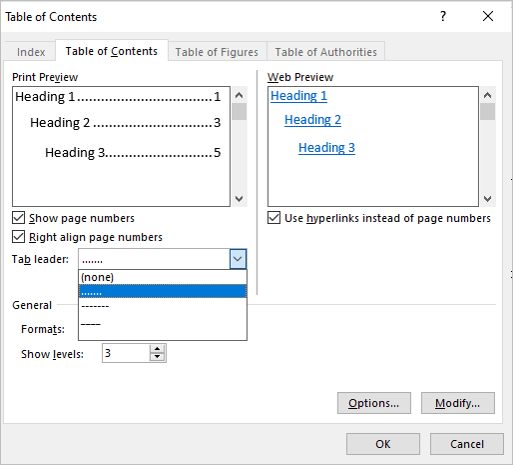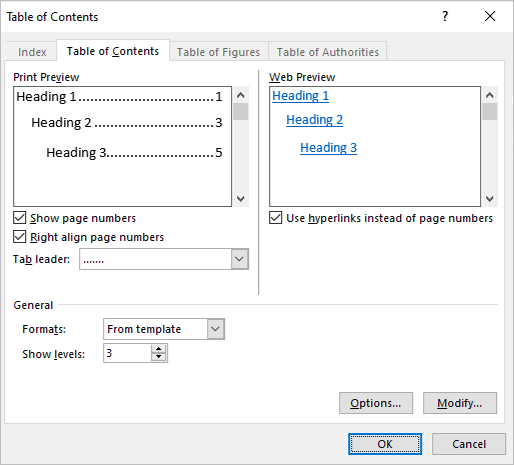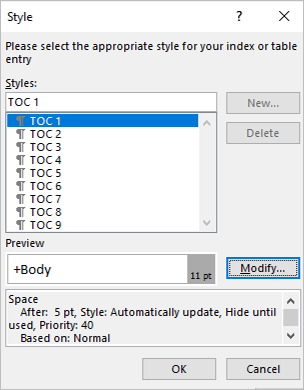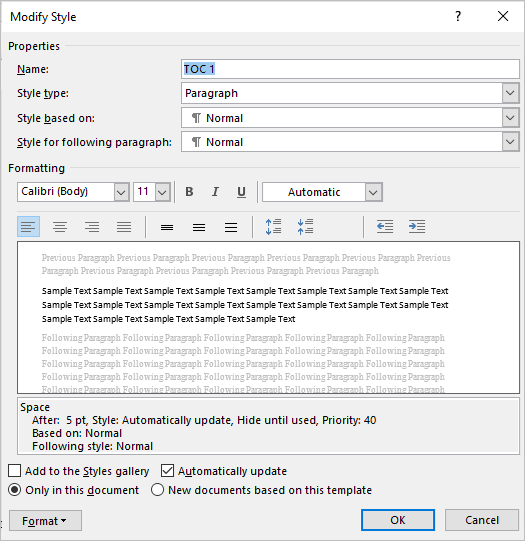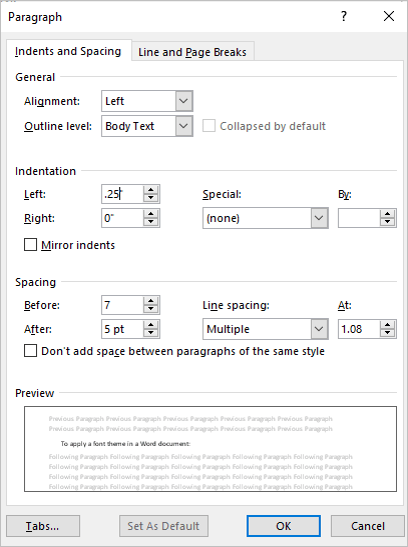Modify Table of Contents or TOC Formatting in a Word Document (including Fonts, Indents and Spacing)
by Avantix Learning Team | Updated June 23, 2022
Applies to: Microsoft® Word® 2013, 2016, 2019, 2021 or 365 (Windows)
If you have created an automatic or custom table of contents (TOC) using heading styles, you can modify the formatting of the table of contents using TOC styles. TOC styles are created automatically based on heading levels. For example, if you have included 3 heading styles when you generated your TOC, Word will create 3 TOC styles that you can modify to quickly change the format your table of contents.
Recommended article: How to Create a Table of Contents in Word
Do you want to learn more about Microsoft Word? Check out our virtual classroom or in-person classroom Word courses >
Modify a table of contents by changing or removing tab leaders
Table of contents appear by default with tab leaders (such as dots or periods).
To easily change or remove tab leaders for the entire table of contents:
- Click in the automatic or custom table of contents.
- Click the References tab in the Ribbon.
- Click Table of Contents in the Table of Contents group. A drop-down menu appears.
- Select Custom Table of Contents. A dialog box appears.
- From the Tab leader drop-down menu, select a different leader or None.
- Click OK.
Tab leader options appear in the Table of Contents dialog box as follows:
Modify TOC styles to change the format of table of contents entries
To modify a table of contents or TOC style:
- Click in the automatic or custom table of contents.
- Click the References tab in the Ribbon.
- Click Table of Contents in the Table of Contents group. A drop-down menu appears.
- Select Custom Table of Contents. A dialog box appears.
- Ensure From Template is selected beside Formats.
- Click Modify. A dialog box appears. You can modify the TOC styles in the table of contents. For example, if you have generated the table of contents from 3 heading levels, 3 TOC styles can be modified. These styles appear in a hierarchy (TOC is the top level).
- Click the TOC style you want to modify.
- Click Modify. The Modify Styles dialog box appears. Turn off Automatically Update Styles (so users can't format the TOC in the document and change formatting throughout the TOC). It's also a good idea to ensure New Documents Based on This Template is not selected so that you don't change TOC formatting in the template (typically the Normal template).
- Make any formatting changes you want such as font size and font color. You can also click Format at the bottom of the dialog box and select Font or Paragraph from the drop-down menu.
- Continue clicking OK to close the dialog boxes.
Note in the Table of Contents dialog box below that From template is selected beside Formats:
The Style dialog box appears with TOC styles after you click Modify in the Table of Contents dialog box (note that Format appears on the bottom left and offers Font, Paragraph and other options):
The Modify Style dialog box appears after you click Modify in the Style dialog box:
Change fonts in a table of contents
You can use the method above to change the font for each TOC level. However, if you have used themes in your Word document, the TOC styles should pick up the font based on the font theme.
Font themes are applied using the Design tab in the Ribbon.
To apply a font theme in a Word document:
- Click the Design tab in the Ribbon.
- Click Fonts in the Document Formatting group. A drop-down menu appears.
- Select a Font theme.
It's a good idea to select a font theme or document theme with the font theme you want when you first create a Word document. If users manually change the font, this overrides the theme.
Change indents and spacing in a table of contents
You can also modify the indents and spacing in TOC styles. Indents and spacing (above and below) are paragraph formats.
To change the indents and spacing in a TOC style:
- Click in the automatic or custom table of contents.
- Click the References tab in the Ribbon.
- Click Table of Contents in the Table of Contents group. A drop-down menu appears.
- Select Custom Table of Contents. A dialog box appears.
- Ensure From Template is selected beside Formats.
- Click Modify. A dialog box appears.
- Click the TOC style you want to modify.
- Click Modify. The Modify Styles dialog box appears. Ensure Automatically Update is unchecked.
- Click Format at the bottom of the dialog box. A drop-down menu appears.
- Select Paragraph. The Paragraph dialog box appears.
- Enter the desired indents (typically in inches or centimeters based on your measurement system). It's common here to change the left indent.
- Enter values in the Before and / or After areas below Spacing (in points).
- Continue clicking OK to close the dialog boxes.
The Paragraph dialog box appears when you click Format and then select Paragraph in the Modify Styles dialog box as follows:
There are several other options In the Format menu in the Modify Styles dialog box that are worth exploring including Tabs and Borders.
Subscribe to get more articles like this one
Did you find this article helpful? If you would like to receive new articles, JOIN our email list.
More resources
How to Create, Edit, Use and Save Templates in Microsoft Word
10 Microsoft Word Navigation Shortcuts for Moving Around Faster
How to Add or Edit Heading Levels in a Table of Contents in Word
How to Keep Text Together in Microsoft Word (Words, Lines or Paragraphs)
How to Convert a PDF to Word in Microsoft Office (No Third Party Programs Needed)
Related courses
Microsoft Word: Intermediate / Advanced
Microsoft Excel: Intermediate / Advanced
Microsoft PowerPoint: Intermediate / Advanced
Microsoft Word: Long Documents Master Class
Microsoft Word: Styles, Templates and Tables of Contents
Microsoft Word: Designing Dynamic Word Documents Using Fields
Our instructor-led courses are delivered in virtual classroom format or at our downtown Toronto location at 18 King Street East, Suite 1400, Toronto, Ontario, Canada (some in-person classroom courses may also be delivered at an alternate downtown Toronto location). Contact us at info@avantixlearning.ca if you'd like to arrange custom instructor-led virtual classroom or onsite training on a date that's convenient for you.
Copyright 2024 Avantix® Learning
You may also like
How to Insert or Type I with an Accent Mark in Word (Í, í, Ì, ì, Î, î, Ï, or ï)
You can insert or type i with an accent mark in Word using built-in tools or keyboard shortcuts (including Alt code shortcuts). The letter i can be inserted with an accent in both upper or lower case. The following are common accented characters that you can insert or type in Word in upper or lower case: grave (Ì or ì), acute (Í or í), circumflex (Î or î) and umlaut (Ï or ï).
How to Insert or Type A with an Accent Mark in Word (À, Á, Â, Ä, à, á, â, or ä)
You can insert or type a with an accent mark in Word using built-in tools or keyboard shortcuts (including Alt code shortcuts). The letter a can be inserted with an accent in both upper or lower case. The following are common accented characters that you can insert or type in Word in upper or lower case: grave (À or à), acute (Á or á), circumflex (Â or â) and umlaut (Ä or ä).
10 Word Shortcuts to Select Text Using a Keyboard
You can use several shortcuts in Word to select text in your documents using only your keyboard. When you select text, it will typically be highlighted in grey. After you select text, you can cut, copy, or delete the selected text or apply character or paragraph formatting.
Microsoft, the Microsoft logo, Microsoft Office and related Microsoft applications and logos are registered trademarks of Microsoft Corporation in Canada, US and other countries. All other trademarks are the property of the registered owners.
Avantix Learning |18 King Street East, Suite 1400, Toronto, Ontario, Canada M5C 1C4 | Contact us at info@avantixlearning.ca


